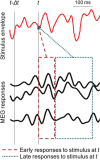Cortical Representations of Speech in a Multitalker Auditory Scene
- PMID: 28821680
- PMCID: PMC5607465
- DOI: 10.1523/JNEUROSCI.0938-17.2017
Cortical Representations of Speech in a Multitalker Auditory Scene
Abstract
The ability to parse a complex auditory scene into perceptual objects is facilitated by a hierarchical auditory system. Successive stages in the hierarchy transform an auditory scene of multiple overlapping sources, from peripheral tonotopically based representations in the auditory nerve, into perceptually distinct auditory-object-based representations in the auditory cortex. Here, using magnetoencephalography recordings from men and women, we investigate how a complex acoustic scene consisting of multiple speech sources is represented in distinct hierarchical stages of the auditory cortex. Using systems-theoretic methods of stimulus reconstruction, we show that the primary-like areas in the auditory cortex contain dominantly spectrotemporal-based representations of the entire auditory scene. Here, both attended and ignored speech streams are represented with almost equal fidelity, and a global representation of the full auditory scene with all its streams is a better candidate neural representation than that of individual streams being represented separately. We also show that higher-order auditory cortical areas, by contrast, represent the attended stream separately and with significantly higher fidelity than unattended streams. Furthermore, the unattended background streams are more faithfully represented as a single unsegregated background object rather than as separated objects. Together, these findings demonstrate the progression of the representations and processing of a complex acoustic scene up through the hierarchy of the human auditory cortex.SIGNIFICANCE STATEMENT Using magnetoencephalography recordings from human listeners in a simulated cocktail party environment, we investigate how a complex acoustic scene consisting of multiple speech sources is represented in separate hierarchical stages of the auditory cortex. We show that the primary-like areas in the auditory cortex use a dominantly spectrotemporal-based representation of the entire auditory scene, with both attended and unattended speech streams represented with almost equal fidelity. We also show that higher-order auditory cortical areas, by contrast, represent an attended speech stream separately from, and with significantly higher fidelity than, unattended speech streams. Furthermore, the unattended background streams are represented as a single undivided background object rather than as distinct background objects.
Keywords: attention; auditory cortex; cocktail party problem; magnetoencephalography; stimulus reconstruction; temporal response function.
Copyright © 2017 the authors 0270-6474/17/379189-08$15.00/0.
Figures





Similar articles
-
Left Superior Temporal Gyrus Is Coupled to Attended Speech in a Cocktail-Party Auditory Scene.J Neurosci. 2016 Feb 3;36(5):1596-606. doi: 10.1523/JNEUROSCI.1730-15.2016. J Neurosci. 2016. PMID: 26843641 Free PMC article.
-
The encoding of auditory objects in auditory cortex: insights from magnetoencephalography.Int J Psychophysiol. 2015 Feb;95(2):184-90. doi: 10.1016/j.ijpsycho.2014.05.005. Epub 2014 May 16. Int J Psychophysiol. 2015. PMID: 24841996 Free PMC article. Review.
-
Neural coding of continuous speech in auditory cortex during monaural and dichotic listening.J Neurophysiol. 2012 Jan;107(1):78-89. doi: 10.1152/jn.00297.2011. Epub 2011 Oct 5. J Neurophysiol. 2012. PMID: 21975452 Free PMC article.
-
Cortical Tracking of Speech-in-Noise Develops from Childhood to Adulthood.J Neurosci. 2019 Apr 10;39(15):2938-2950. doi: 10.1523/JNEUROSCI.1732-18.2019. Epub 2019 Feb 11. J Neurosci. 2019. PMID: 30745419 Free PMC article.
-
Functional imaging of auditory scene analysis.Hear Res. 2014 Jan;307:98-110. doi: 10.1016/j.heares.2013.08.003. Epub 2013 Aug 19. Hear Res. 2014. PMID: 23968821 Review.
Cited by
-
Neural speech restoration at the cocktail party: Auditory cortex recovers masked speech of both attended and ignored speakers.PLoS Biol. 2020 Oct 22;18(10):e3000883. doi: 10.1371/journal.pbio.3000883. eCollection 2020 Oct. PLoS Biol. 2020. PMID: 33091003 Free PMC article.
-
Cognitive resources are distributed among the entire auditory landscape in auditory scene analysis.Psychophysiology. 2020 Feb;57(2):e13487. doi: 10.1111/psyp.13487. Epub 2019 Oct 2. Psychophysiology. 2020. PMID: 31578762 Free PMC article.
-
Effect of Task and Attention on Neural Tracking of Speech.Front Neurosci. 2019 Sep 16;13:977. doi: 10.3389/fnins.2019.00977. eCollection 2019. Front Neurosci. 2019. PMID: 31607841 Free PMC article.
-
Brainstem-cortical functional connectivity for speech is differentially challenged by noise and reverberation.Hear Res. 2018 Sep;367:149-160. doi: 10.1016/j.heares.2018.05.018. Epub 2018 May 26. Hear Res. 2018. PMID: 29871826 Free PMC article.
-
Attention, musicality, and familiarity shape cortical speech tracking at the musical cocktail party.Brain Lang. 2025 Jul;266:105581. doi: 10.1016/j.bandl.2025.105581. Epub 2025 Apr 25. Brain Lang. 2025. PMID: 40286491
References
-
- Ahveninen J, Hämäläinen M, Jääskeläinen IP, Ahlfors SP, Huang S, Lin FH, Raij T, Sams M, Vasios CE, Belliveau JW (2011) Attention-driven auditory cortex short-term plasticity helps segregate relevant sounds from noise. Proc Natl Acad Sci U S A 108:4182–4187. 10.1073/pnas.1016134108 - DOI - PMC - PubMed
-
- Bregman AS. (1994) Auditory scene analysis: the perceptual organization of sound. Cambridge, MA: MIT.
-
- Cherry EC. (1953) Some experiments on the recognition of speech, with one and with 2 ears. J Acoust Soc Am 25:975–979. 10.1121/1.1907229 - DOI
Publication types
MeSH terms
Grants and funding
LinkOut - more resources
Full Text Sources
Other Literature Sources
